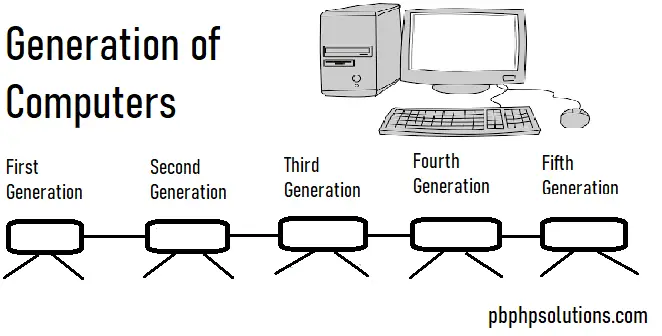Before getting started with the generation of computers with their characteristics, let us discuss the basic knowledge of computers and their peripherals.

What is a Computer
A computer is an electronic device capable of manipulating numbers and symbols under the control of a set of instructions known as a computer program.
A computer program directs the computer to solve a particular problem and display results. Computer programs are written using programming languages such as BASIC, FORTRAN, COBOL, PASCAL, C, ALGOL, and so on.
Read also, How to add Google Map to Website with Marker
Computer Hardware and Software
A computer basically consists of electronic components which are supported by electrical devices and mechanical systems. All these electronic, electrical, and mechanical components used in a computer are called computer hardware.
Computer hardware components are actuated and controlled with the help of computer programs called a computer software. Computer software is classified into two categories.
- Application Softwares are programs that are used to solve specific problems or tasks such as railway reservation systems, banking applications, hotel management systems, employee management systems, HR management systems, etc.
- System software is programs that are used to control the hardware and peripherals. On the other hand, we can execute the application programs with the help of system software. For eg:- Operating systems and language processors are considered the system software.
The total Generation of Computers is described one by one below
Computers became commercially available during the early 1950s and many significant technological developments have taken place thereafter. The stages of development are termed the first, second, third, fourth, and fifth.
First Generation
The characteristics of first-generation computers
- Vacuum tubes are used as principal electronic components which occupied large spaces and generated more heat.
- The speed of computing was measured in milliseconds.
- The storage capacity was limited.
- For the operation of input and outputs, punched cards were used.
Second Generation
The characteristics of the second generation computers
- Electronic components of the solid-state like diodes and transistors were used as the principal electronic components.
- The speed of computing was measured in microseconds.
- Considerable reduction in heat generation.
- Remarkable improvement in reliability.
- Increased storage capacity.
- Magnetic tapes besides punched cards are also used for input/ output operations.
Third Generation Computers
The characteristics of the third generation computers
- Use of Integrated Circuits (IC).
- The speed of computing was measured in nanoseconds.
- Occupied less, space.
- Improved input / Output devices like visual display unit( monitor ), line printers and magnetic tapes, etc were used.
Fourth Generation Computers
The characteristics of the fourth generation computers
- Use of microprocessor chip ( The entire CPU i.e. central processing unit on a single chip ).
- The speed of computing was measured in nano and picoseconds.
- Occupied less space.
- Commonly available as personal computers.
- Mini and microcomputers were developed from microprocessors.
Fifth Generation Computers
The characteristics of the fifth generation computers
- Use of super large scale integration (SLSI) chip in computers (supercomputers).
- Supercomputers are capable of performing millions of instructions in a second.
- The speed of processing is high.
- Use of RISC (Reduced Instructions Set Computing) for processing.
- The fifth-generation computers are very expensive.
Read also, How to send email in PHP with example
Conclusion:- I hope this tutorial will help you to understand the overview of computer generations.